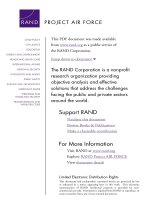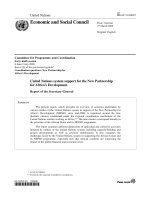Air Force Service Procurement - Approaches for Measurement and Management pptx
Bạn đang xem bản rút gọn của tài liệu. Xem và tải ngay bản đầy đủ của tài liệu tại đây (323.94 KB, 88 trang )
This PDF document was made available
from www.rand.org as a public service of
the RAND Corporation.
6
Jump down to document
Visit RAND at www.rand.org
Explore RAND Project AIR FORCE
View document details
This document and trademark(s) contained herein are protected by law
as indicated in a notice appearing later in this work. This electronic
representation of RAND intellectual property is provided for non-
commercial use only. Permission is required from RAND to reproduce, or
reuse in another form, any of our research documents.
Limited Electronic Distribution Rights
For More Information
CHILD POLICY
CIVIL JUSTICE
EDUCATION
ENERGY AND ENVIRONMENT
HEALTH AND HEALTH CARE
INTERNATIONAL AFFAIRS
NATIONAL SECURITY
POPULATION AND AGING
PUBLIC SAFETY
SCIENCE AND TECHNOLOGY
SUBSTANCE ABUSE
TERRORISM AND
HOMELAND SECURITY
TRANSPORTATION AND
INFRASTRUCTURE
The RAND Corporation is a nonprofit
research organization providing
objective analysis and effective
solutions that address the challenges
facing the public and private sectors
around the world.
Purchase this document
Browse Books & Publications
Make a charitable contribution
Support RAND
This product is part of the RAND Corporation monograph series.
RAND monographs present major research findings that address the
challenges facing the public and private sectors. All RAND mono-
graphs undergo rigorous peer review to ensure high standards for
research quality and objectivity.
Laura H. Baldwin, John A. Ausink, Nancy Nicosia
Prepared for the United States Air Force
Approved for public release; distribution unlimited
Air Force Service
Procurement
Approaches for Measurement
and Management
The RAND Corporation is a nonprofit research organization providing
objective analysis and effective solutions that address the challenges
facing the public and private sectors around the world. RAND’s
publications do not necessarily reflect the opinions of its research clients
and sponsors.
R
®
is a registered trademark.
© Copyright 2005 RAND Corporation
All rights reserved. No part of this book may be reproduced in any
form by any electronic or mechanical means (including photocopying,
recording, or information storage and retrieval) without permission in
writing from RAND.
Published 2005 by the RAND Corporation
1776 Main Street, P.O. Box 2138, Santa Monica, CA 90407-2138
1200 South Hayes Street, Arlington, VA 22202-5050
201 North Craig Street, Suite 202, Pittsburgh, PA 15213-1516
RAND URL: />To order RAND documents or to obtain additional information, contact
Distribution Services: Telephone: (310) 451-7002;
Fax: (310) 451-6915; Email:
Library of Congress Cataloging-in-Publication Data
Baldwin, Laura H., 1967–
Air Force service procurement : approaches for measurement and management /
Laura H. Baldwin, John A. Ausink, Nancy Nicosia.
p. cm.
“MG-299.”
Includes bibliographical references.
ISBN 0-8330-3714-5 (pbk. : alk. paper)
I. Ausink, John A. II. Nicosia, Nancy. III. Title.
UC267.B35 2005
358.4'16212'0973—dc22
2004028312
The research reported here was sponsored by the United States Air
Force under contract F49642-01-C-0003. Further information may be
obtained from the Strategic Planning Division, Directorate of Plans, Hq
USAF.
iii
Preface
This report documents RAND Corporation research on a portfolio of
metrics that may be useful in managing service acquisitions for the
Air Force Program Executive Officer for Combat and Mission Sup-
port (AFPEO/CM). This research is based on a series of interviews
with commercial sector purchasing professionals who are respected by
their peers for their successful creation and implementation of what
are widely accepted as best purchasing and supply management prac-
tices, particularly in the area of service acquisitions.
This research was part of a broader study entitled “Supporting
Air Force Procurement Transformation and Laying the Groundwork
for Services Acquisition Reform,” sponsored by the Air Force Deputy
Assistant Secretary for Contracting and conducted within the Re-
source Management Program of RAND Project AIR FORCE.
This report is designed to assist federal agency personnel seeking
to identify opportunities for improving the outcomes of purchased
goods and services through application of best practices for purchas-
ing and supply management. As such, it assumes a basic understand-
ing of best commercial purchasing and supply management practices.
Readers may also be interested in the following related RAND docu-
ments (which are available on the web, see />Abstracts):
• Air Force Procurement Workforce Transformation: Lessons from the
Commercial Sector, John Ausink, Laura H. Baldwin, and Chris-
topher Paul, MG-214-AF, 2004.
iv Air Force Service Procurement: Approaches for Measurement and Management
• Defining Needs and Managing Performance of Installation Support
Contracts: Perspectives from the Commercial Sector, Laura H.
Baldwin and Sarah Hunter, MR-1812-AF, 2004.
• Measuring Changes in Service Costs to Meet the Requirements of
the 2002 National Defense Authorization Act, Chad Shirley, John
Ausink, and Laura H. Baldwin, MR-1821-AF, 2004.
• Using a Spend Analysis to Help Identify Prospective Air Force Pur-
chasing and Supply Management Initiatives: Summary of Selected
Findings, Nancy Y. Moore, Cynthia R. Cook, Charles Linden-
blatt, and Clifford A. Grammich, DB-434-AF, 2004.
• Implementing Best Purchasing and Supply Management Practices:
Lessons from Innovative Commercial Firms, Nancy Y. Moore,
Laura H. Baldwin, Frank Camm, and Cynthia R. Cook, DB-
334-AF, 2002.
• Implementing Performance-Based Services Acquisition (PBSA):
Perspectives from an Air Logistics Center and a Product Center,
John Ausink, Laura H. Baldwin, Sarah Hunter, and Chad
Shirley, DB-388-AF, 2002.
• Federal Contract Bundling: A Framework for Making and Justify-
ing Decisions for Purchased Services, Laura H. Baldwin, Frank
Camm, and Nancy Y. Moore, MR-1224-AF, 2001.
• Performance-Based Contracting in the Air Force: A Report on Expe-
riences in the Field, John Ausink, Frank Camm, and Charles
Cannon, DB-342-AF, 2001.
• Strategic Sourcing: Measuring and Managing Performance, Laura
H. Baldwin, Frank Camm, and Nancy Y. Moore, DB-287-AF,
2000.
• Incentives to Undertake Sourcing Studies in the Air Force, Laura
H. Baldwin, Frank Camm, Edward G. Keating, and Ellen M.
Pint, DB-240-AF, 1998.
• Strategic Sourcing: Theory and Evidence from Economics and Busi-
ness Management, Ellen M. Pint and Laura H. Baldwin, MR-
865-AF, 1997.
Preface v
RAND Project AIR FORCE
RAND Project AIR FORCE (PAF), a division of the RAND Corpo-
ration, is the U.S. Air Force's federally funded research and develop-
ment center for studies and analyses. PAF provides the Air Force with
independent analyses of policy alternatives affecting the development,
employment, combat readiness, and support of current and future
aerospace forces. Research is conducted in four programs: Aerospace
Force Development; Manpower, Personnel, and Training; Resource
Management; and Strategy and Doctrine.
Additional information about PAF is available on our web site at
/>
vii
Contents
Preface iii
Figure and Tables
ix
Summary
xi
Acknowledgments
xv
Abbreviations and Acronyms
xvii
CHAPTER ONE
Introduction 1
AFPEO/CM Office and Responsibilities
4
AFPEO/CM Metrics
5
Research Approach
6
Preview of Findings
8
Organization of the Report
9
CHAPTER TWO
Commercial Strategies for Service Procurement 11
Developing Purchasing Strategies
13
Strategies and Commodity Councils
15
CHAPTER THREE
Commercial Firms’ Use of Metrics to Manage Service Procurements 19
Results-Oriented Metrics
20
Cost
20
Quality
25
Supplier Satisfaction
27
viii Air Force Service Procurement: Approaches for Measurement and Management
New Initiatives 29
Special Interest
30
Internal Management Metrics
30
Internal Customer Satisfaction
31
Personnel Training and Retention
33
Ethics Violations
34
Metrics Baseline Data
34
Reporting Metrics to High-Level Corporate Management
35
CHAPTER FOUR
Recommendations for the Air Force 37
Metrics
38
Cost
38
Quality
42
Supplier Satisfaction
44
Initiatives and New Policies
45
Special Interest
47
Internal Management
49
Overarching Data Issue
49
Management Approach
50
Commodity Councils
50
Leadership and Incentives
53
Link to Metrics Portfolio
54
Summary
54
APPENDIX
Interview Questions 55
References
65
ix
Figure and Tables
Figure
2.1. Linkage Between Corporate Objectives and
Purchasing Strategies
14
Tables
S.1. Proposed Portfolio of Metrics for the AFPEO/CM xiv
3.1. Cost Metrics
21
3.2. Illustrative Example of Calculating Cost Changes Relative to
Indices
22
3.3. Quality Metrics
25
3.4. Supplier Satisfaction Metrics
27
3.5. Illustrative Initiative Metrics
29
3.6. Special Interest Metrics
30
3.7. Internal Management Metrics
31
4.1. Proposed Portfolio of Metrics for the AFPEO/CM
39
xi
Summary
To satisfy requirements in the fiscal year 2002 National Defense
Authorization Act (U.S. Congress, 2001) to improve the acquisition
of services by the Department of Defense, the Air Force established a
Program Executive Officer for Combat and Mission Support
(AFPEO/CM) who is responsible for management and oversight of a
well-defined portfolio of Air Force services acquisition activities. This
office is the single point of contact for Air Force services acquisition
inquiries and is also responsible for developing long-range plans for
cost-effective acquisition of services.
To fulfill its responsibilities, the AFPEO/CM needs metrics to
help it monitor compliance with statutory requirements, needs to re-
spond to congressional inquiries about specific acquisitions, and
needs to effectively manage Air Force services acquisition activities
and organizations. RAND Project AIR FORCE was asked to help
develop a portfolio of “overarching” measures that will allow the
AFPEO/CM to assess the health of Air Force acquisition activities,
diagnose problems, and target improvement efforts. This report de-
scribes our recommendations.
To help develop this portfolio of metrics, we considered the ex-
perience of commercial firms, which have long had a “strategic” view
of purchasing direct materials (goods) because they are direct inputs
to production, but have only recently explored applying such ap-
proaches to purchasing services. Through interviews with well-
respected chief purchasing officers and other executives involved in
service acquisitions, through conference participation, and through a
xii Air Force Service Procurement: Approaches for Measurement and Management
review of the business literature, we found that commercial firms are
beginning to manage their service acquisitions in a manner similar to
their acquisition of direct materials. That is, commercial firms are in-
creasingly making use of commodity councils (cross-functional
teams) to develop purchasing and supply management strategies for
services and are developing and using performance metrics, similar to
those used for goods, to manage their purchased services and their
purchasing organizations (pp. 11–12).
Purchasing and Supply Management Strategies
Ideally, corporate objectives flow down through the purchasing orga-
nization and are supported through formal strategies for individual
commodity groups, as well as personnel incentives. Strategies are
based on intensive market research and assessments of internal de-
mands for services. Because of the many facets of purchasing and
supply management strategies, commodity councils typically include
a variety of experts such as representatives of user groups, experts in
purchasing/acquisition, and experts in the particular service industry.
Industry experts or other stakeholders, rather than procurement per-
sonnel, may be tapped to lead commodity councils (pp. 11–17).
Commercial Approaches to Metrics
Commercial firms rely on results-oriented metrics that focus on how
acquisition activities support corporate objectives to manage their
service acquisition activities. The categories of results-oriented metrics
that appeared most often in our research include cost, quality, sup-
plier satisfaction, implementation of new initiatives, and special inter-
est items. In addition to these results-oriented metrics, commercial
firms indicated that management metrics that track internal customer
satisfaction, personnel training and retention, and ethics violations
are also important. Selected metrics are reported to top-level execu-
tives on a regular basis (pp. 19–35).
Summary xiii
Developing a baseline for these metrics and then tracking them
over time present challenges for many firms. Some firms have
adopted new management information systems to collect and orga-
nize the data for their service acquisitions and have implemented sur-
veys to collect additional data such as supplier satisfaction and cus-
tomer satisfaction with purchased services, the purchasing
organization, and its processes (p. 34).
Recommendations for the Air Force
While not a commercial firm, the Air Force can learn from commer-
cial firms’ experiences in managing its service acquisitions. We rec-
ommend a balanced portfolio of performance metrics for the
AFPEO/CM based on the six major categories of metrics discussed
above (pp. 37–50). These metrics are listed in Table S.1.
As with commercial firms, populating these metrics will be
challenging for the Air Force. Some of the required data, such as con-
tract costs, exist in Air Force contracting data systems. However, we
have concerns about the integrity of these data and their usefulness in
determining what services the Air Force purchases (Dixon et al.,
forthcoming). The Air Force will need to implement new data collec-
tion procedures for many of the required data, particularly supplier
and customer satisfaction data (pp. 38–50).
Because of commercial sector successes and limited federal gov-
ernment experience with centralized purchasing strategies, we rec-
ommend the Air Force adopt a centralized, strategic approach linked
to Air Force objectives for managing its purchased services. Proposed
Department of Defense–wide commodity councils for selected cate-
gories of services are a step in this direction. Given the diversity of
service users and their requirements, it will be important to include
all-important user groups in the process of developing strategies for
categories of services. Other key stakeholders such as small business
advocates should be included in the process as well. The Air Force
will need to reinforce these efforts with leadership support and incen-
tives that are aligned with Air Force objectives (pp. 50–54).
xiv Air Force Service Procurement: Approaches for Measurement and Management
Table S.1
Proposed Portfolio of Metrics for the AFPEO/CM
Metrics Category Potential Metrics
Cost Change in costs versus change in market index
Actual versus projected post-study costs for recently
completed A-76 studies
Procurement return on investment
Quality Customer satisfaction with purchased services
Reliability or continuity of services
Supplier satisfaction Supplier satisfaction with doing business with the Air
Force
New initiatives Process and outcome metrics for specific initiatives, which
may include
• purchasing and supply management
• management and oversight of acquisition of services
process
• customer education
Special interest Compliance
• Percentage of service dollars and contracts awarded to
different categories of small businesses
• Percentage of service contracts that are performance
based
Other
• Percentage of A-76 studies or slots that were success-
fully competed within the required time frame
• Number of protests resulting from A-76 awards
• Percentage of key staff for A-76 studies that remain in
their jobs throughout those studies
• Percentage of provider personnel that remain in their
jobs for a given period of time
Internal management Internal customer satisfaction with the Air Force purchas-
ing process and personnel
Percentage of dollars associated with purchases executed
outside the Air Force’s preferred strategy (i.e., maverick
buying)
xv
Acknowledgments
We wish to thank the purchasing professionals who took time to
meet with us and teach us about their approaches to managing their
firms’ service acquisitions. Assurances of anonymity prevent us from
identifying them here, but this research would not have been possible
without their help.
We thank Steve Busch, AFPEO/CM, for his help in shaping
this research to ensure that it addressed the correct issues and con-
cerns.
We are also grateful to our RAND colleagues Lloyd Dixon,
Edward Keating, Nancy Moore, and Chad Shirley for their insights
on Air Force service acquisitions and data. Nick Castle and Chris
Nelson provided helpful comments on an early draft of this report.
Judy Lesso, from the RAND library, helped conduct our literature
review; Mary DeBold provided document preparation assistance; and
Christina Pitcher’s skillful editing added clarity to our final manu-
script.
xvii
Abbreviations and Acronyms
AFPEO/CM Air Force Program Executive Officer for Combat
and Mission Support
CAPS Center for Advanced Purchasing Studies
CPO Chief Purchasing Officer
DoD Department of Defense
FAR Federal Acquisition Regulations
GAO General Accounting Office
ISM Institute for Supply Management
MEO Most Efficient Organization
NIB/NISH National Industries for the Blind/National Indus-
tries for the Severely Handicapped
PBSA Performance-Based Services Acquisition
PEO Program Executive Officer
ROI Return on Investment
1
CHAPTER ONE
Introduction
Federal agencies purchase a wide range of goods and services each
year. During the 1990s, services became an increasingly important
spending category, and they currently represent the largest category of
government purchases. The Department of Defense (DoD) is the
largest purchaser of services within the federal government, spending
approximately $93 billion on services in fiscal year 2002 (FY02). This
represents an increase of 18 percent since FY01.
1
Services purchased
by the DoD include commercial services for installations and facilities
such as building maintenance, grounds keeping, and janitorial serv-
ices; professional services such as consulting and engineering support;
and weapon system services such as research and development, test
and evaluation, and maintenance and modification activities.
The DoD has long sought to ensure that its appropriations are
used as effectively and efficiently as possible. When acquisition re-
form—which encompasses a wide range of changes to procurement
regulations, policies, and practices—received increasing emphasis
during the 1990s, early efforts focused on the purchase of weapon
systems and other hardware. However, as services have grown in
budgetary importance, acquisition reform for service purchases has
become a priority.
2
____________
1
For more details, see GAO (2003), GAO (2002), GAO (2001), and Davis (2001).
2
In principle, the same kinds of reforms should be applicable to both goods and services. As
we will see in Chapters Two and Three, management philosophies and metrics used by
commercial firms for categories of purchased goods and services are quite similar.
2 Air Force Service Procurement: Approaches for Measurement and Management
Traditional service contracts specified how providers should per-
form the work rather than allowing them the freedom to pursue the
best way to meet their customers’ needs. One tenet of services acquisi-
tion reform shifts federal agencies away from this paradigm toward
the use of performance-based contracts. Part 37.601 of the Federal
Acquisition Regulations (FAR) defines four requirements of a per-
formance-based service contract: (1) tell the contractor what is
needed, rather than how to provide the service; (2) establish measur-
able performance standards and a quality assurance plan to determine
whether the service meets the contract requirements; (3) reduce the
fee or price when the service does not meet those requirements (nega-
tive incentives); and (4) use performance (positive) incentives where
appropriate. The combination of an outcome orientation and focus
on incentives is meant to promote service innovation and reduce
costs.
Performance-based service contracts gained attention in the fed-
eral government in the early 1990s (Office of Federal Procurement
Policy, 1991).
3
The Air Force issued an instruction for implementing
performance-based service contracts in 1999, which was updated in
February 2004 (U.S. Air Force, 2004). In April 2000, Jacques Gan-
sler, the Undersecretary of Defense for Acquisition and Technology,
established a goal that a minimum of 50 percent of DoD service ac-
quisitions, measured in both dollars and contracts, be performance
based by the year 2005 (Gansler, 2000). The Office of Management
and Budget affirmed the use of performance-based contracts across
the federal government in a March 2001 memorandum by establish-
ing an interim goal that 20 percent of FY02 federal service contract
dollars be awarded through performance-based contracts (O’Keefe,
2001). In addition, the National Defense Authorization Act for FY02
(U.S. Congress, 2001) (hereafter referred to as the FY02 Act) prohib-
____________
3
See Diernisse (2003) for another discussion of the evolution of performance-based service
contracts.
Introduction 3
ited the use of service contracts in the DoD that are not performance
based without prior approval.
4
To encourage the DoD to fundamentally change the way it ap-
proaches its services acquisition activities, the FY02 Act included a
requirement to demonstrate 10 percent savings in service contract
costs (relative to a baseline of FY00 costs) by FY11 through use of
performance-based service contracts, increased competition, and
management innovations. The DoD was ordered to report estimates
of savings to Congress annually through 2005.
5
The FY02 Act also directed all DoD agencies to establish a
management structure for the procurement of services that would be
comparable to the structure used for the procurement of products.
Each agency was to designate an official to be responsible for the
management of the procurement of services. The Secretary of De-
fense was authorized by the FY02 Act to establish the dollar thresh-
olds and other criteria for the approval of purchases of services, and
agencies were required to collect and analyze data on purchases.
The FY03 version of the National Defense Authorization Act
(U.S. Congress, 2002b) removed the specific savings goals of the
FY02 Act, but assumed that savings would be achieved: Congress es-
tablished the goal of using Performance-Based Service Acquisitions
(PBSA) for 70 percent of all service acquisitions by 2011,
6
and it re-
duced the FY03 authorization for the purchase of services by $183
million.
7
The FY04 version of the National Defense Authorization
Act further reinforces the preference for performance-based service
contracts by amending the Office of Federal Procurement Policy Act
so that performance-based contracts that satisfy certain conditions
____________
4
However, the definition of “performance based” in the act is different than the one in FAR
Part 37. The act specifies that a performance-based contract “includes the use of performance
work statements that set forth contract requirements in clear, specific, and objective terms
with measurable outcomes.” See U.S. Congress, 2001, Section 801.2330a.
5
See U.S. Congress, 2001, Section 802, “Savings Goals for Procurements of Services.”
6
U.S. Congress, 2002b.
7
U.S. Congress, 2002a, p. 683. This is approximately a 1.2 percent reduction, based on an
assumed baseline of $50 billion in DoD service contracts.
4 Air Force Service Procurement: Approaches for Measurement and Management
may be treated as contracts for the procurement of commercial serv-
ices (U.S. Congress, 2003, Subtitle C, Section 1431).
[This] will give government customers more discretion to use
best value as a determining factor over cost. The legislation al-
lows government agencies greater flexibility in contracting for a
variety of services available in the private sector, including so-
phisticated services such as management consulting (Phinney,
2003).
AFPEO/CM Office and Responsibilities
In accordance with the FY02 Act, the Air Force established a Pro-
gram Executive Officer for Combat and Mission Support
(AFPEO/CM), whose office is responsible for management and over-
sight of the Air Force’s service acquisition activities that fall within
the AFPEO/CM portfolio. This portfolio includes most service ac-
quisitions greater than $100 million, public-private competitions
conducted under the rules of the Office of Management and Budget
Circular A-76 that involve 300 or more full-time equivalent posi-
tions, special interest service acquisitions, and other acquisitions that
involve significant services. Exceptions include service acquisitions
associated with weapon systems—these fall within the portfolio of the
weapon system PEO—and federally funded research and develop-
ment centers. Numbered Air Force services, construction, architect
and engineering, and housing and utilities privatization activities are
excluded from the AFPEO/CM’s consideration as well.
8
As of No-
vember 2002, the AFPEO/CM’s portfolio included over 120 service
acquisition programs valued at over $60 billion.
9
Among the many challenges the office faces are the identifica-
tion of service acquisitions and the implementation of new strategies
____________
8
See interim changes to the Air Force Federal Acquisition Regulation Supplement Subpart
5337.5 (Clay, 2003) and Cardenas (2004).
9
Per our discussion with Steve Busch, a support contractor in the AFPEO/CM office.
Introduction 5
and initiatives.
10
One particular area of emphasis is implementation
of performance-based contracts for services. The AFPEO/CM office
determines whether service contracts are performance based and must
approve the use of any contracts that are not performance based.
Early efforts of the AFPEO/CM office have focused on im-
proving the execution of service acquisitions by developing and im-
plementing the Management and Oversight of Acquisition of Services
Process. This process implements the FY02 Act by establishing man-
agement controls and reviews to ensure the successful acquisition of
services and the implementation of PBSA practices (Cardenas, 2004).
Over time, the AFPEO/CM organization is expected to take on more
strategic roles as well. As the single point of contact for Air Force
service acquisition inquiries within the Air Force and the DoD, it will
be responsible for developing long-range plans to ensure the effective
and efficient acquisition of services. It will also be a key stakeholder in
designing and implementing future purchasing and supply manage-
ment strategies for Air Force services.
AFPEO/CM Metrics
Successful fulfillment of the AFPEO/CM’s day-to-day responsibilities
requires metrics that monitor compliance with statutory requirements
(implementation of PBSA, achievement of savings goals, etc.), help
respond to inquiries about specific acquisitions or contracts, and assist
in the effective management of the organization (ensuring mainte-
nance of certain skills for the workforce, for example). Metrics will
also be required to ensure the effective management of service acquisi-
tions and extract the most value from suppliers so that the Air Force
can be a good steward of its resources. RAND Project AIR FORCE
was asked to assist in the development of a portfolio of “overarching”
____________
10
This is not an easy problem. There is a great deal of disagreement in the Air Force about
what should be considered a “service” (Ausink et al., 2002). In addition, some services fall
under the domain of other PEOs; yet, they are still subject to Air Force policy on service
acquisitions.









